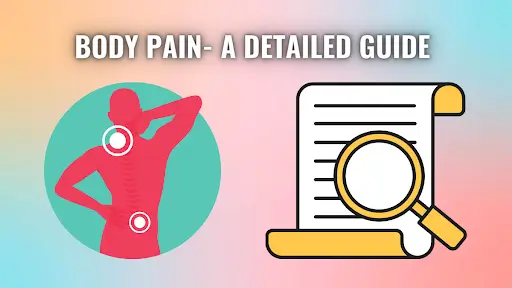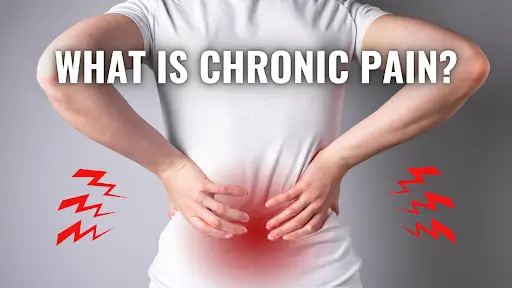- Aches
- Types Of Body Pain
- What Causes Body Aches?
- Symptoms
- Get Rid Of Achy Body
- How To Manage Body Pain
- manage pain naturally
- Body Pain – Conclusion
Body pain has become a common issue with people in today’s world. It can be of two types-
- Acute Pain
- Chronic Pain
In this blog, we discuss the details of body pain. The causes of body pain, the signs and symptoms of body pain, the body pain management, and remedies to get rid of body pain.
What Are Body Aches?
An uncomfortable symptom that is caused by muscle inflammation and soreness. Body aches occur when muscles are inflamed through physical stress or an immune response.
There might be different symptoms of body aches-
1. If you go for a run, walk, or stand for a long period of time, you might feel that your body aches, as the activities might cause muscle stress or strains.
- If you are suffering from a cold or flu, you might feel your body aching.
When your body fights off any infection, it causes short-term muscle inflammation that makes you feel uncomfortable and achy [1].
What Are The Types Of Body Pain?
The experience of pain is different from person to person. Therefore, it is easy to separate pain into different types, which are listed below-
-
Acute Pain
Acute pain remains for a shorter period of time. This pain might cause serious tissue damage, such as bones, muscles, or organs.
-
Chronic Pain
Chronic pain is different in nature and remains for a longer period of time. For instance, osteoarthritis. This pain is more likely to cause mental health issues like depression, anxiety, etc.
Other Ways to Classify Pain:
- Nociceptive – Pain caused by tissue damage.
- Neuropathic – Pain caused by nerve damage.
- Psychogenic – The pain that comes from psychological conditions like stress, depression, anxiety, etc, is called psychogenic pain.
Pain also may be classified by the type of tissue involved or part of the body affected. This pain might also be referred to as muscle pain or joint pain. Pain might also be chest pain or back pain [2].
What Causes Body Aches?
8 different causes of body aches are laid down below-
-
Dehydration –
Water is an essential ingredient for the normal functioning of the body. Lack of water might lead to muscle cramps.
Dehydration symptoms include –
- Exhaustion
- Extreme thirst
- Dizziness or disorientation
- Urine dark in color.
-
Stress –
It is a mental health condition but can impact the body on a cellular level. Stress can cause infection, which leads to inflammation of muscles and might result in aches or pains.
Symptoms of stress and anxiety include-
- Sweating
- Hyperventilating
- Headache
- Trembling
-
Fibromyalgia-
It is a chronic condition that makes your whole body exhausted and achy. The reason behind the condition is unclear; however, rheumatoid arthritis increases the risk.
Symptoms of Fibromyalgia-
- Depression
- Anxiety
- Difficulty in thinking, focusing, and refreshing
- Sleep problems
- Headaches and Migraines
-
Pneumonia-
It is a lung infection that affects the body. The condition can cause chest or muscle pain.
Symptoms of Pneumonia include-
- Dry cough which produces green, yellow, or blood-tinged mucus.
- Low-Appetite
- Confusion
- Fatigue
- Low-Appetite
-
Chronic Fatigue Syndrome –
It is a sleep disorder that blocks the air pathways, causing fragmentation in the sleep cycle.
People suffering from CFS might suffer from muscle aches, along with insomnia, weakness and exhaustion.
-
Arthritis –
It is a condition that occurs when a person’s joints become inflamed. The condition makes the autoimmune system attack the healthy tissues that line the joints.
Pain and achiness are common symptoms of arthritis.
-
Lack of Sleep –
According to many scientists, there is a link between sleep and pain. People experiencing chronic pain find it hard to sleep, or according to many researches, it was found that people suffering from insomnia experience chronic pain.
-
Autoimmune Disorders –
- Lupus- This is a condition where the body’s auto-immune system attacks the healthy tissues, causing inflammation.
- Myositis- It is a condition that causes inflammation of the muscles. Symptoms include fatigue and a general feeling of being unwell.
- Multiple Sclerosis- It is an auto-immune condition that affects the central nervous system and makes the body feel achy [3].
Signs and Symptoms of Body Pain
10 signs and symptoms of Body Pain are listed below-
- Morning stiffness
- Joint Aches or aches all over the body
- Muscle pain and widespread muscle aches
- Rashes
- Difficulty in sleeping or falling asleep
- Headaches
- Anxiety
- Impaired cognitive function and memory problems
- Fatigue
- Swelling [4].
How To Get Rid Of Achy Body?
8 Natural Ways to get rid of body pain are listed below-
- Stay hydrated. Drink at least 8-12 glasses of water daily.
- You should do daily physical exercise, at least a 20-minute walk where the muscle stretches to prevent stiffness.
- Make sure to eat a lot of fruits and vegetables and a lot of complex carbs as part of your diet.
- You should make sure you meet your daily protein diet, like egg whites, soya, fish, meat, and cottage cheese, in your diet routine.
- You should eat walnuts and almonds daily, as they are rich in omega fatty acids that prevent muscle fatigue in the body.
- Drink green tea, orange juice, lemon juice, and coconut water daily.
- You should limit your carbohydrate intake. Take rice for one time and use brown rice instead.
Other ways to get rid of Body Pain
- You should take a bath with warm water. This makes the muscles relax and relieve pain, making you feel better. For better results, you can also add Epsom salts and soak it for 12 minutes. The magnesium in the salt helps the body to relieve pain.
- You should lie down and cover yourself with a blanket; the warm temperature makes the body and muscles relax and helps reduce pain. Heat treatment is really effective in treating pain caused by arthritis or severe muscle pain.
- You can apply peppermint oil, lavender oil, and coconut oil, which act as a remedy for sore muscles.
- You can apply an ice pack on the sore spot. Ice helps to reduce muscle inflammation and pain.
Acupuncture is another method to relieve pain. It is an alternative to over-the-counter medicines and addictive opioids. It is an old traditional Chinese practice where the practitioners use small, thin needles that pierce the skin at specific acupuncture points. There are specifically 2000 acupuncture points connected by pathways called meridians. An energy called Qi (pronounced Chee) flows through these meridians and promotes good overall health.
Pain Management- How To Manage Body Pain

Basically, the treatment options for any pain depend on the underlying cause and severity of the pain.
Treatment might start with conservative therapies like-
- Over-the-counter aspirin
- Acetaminophen or non-steroidal anti-inflammatory drugs (ibuprofen)
The Pain Management specialists recommend interventional therapies like-
Medication Management –
This includes the pain specialist, who will help you with knowledge of how to take the pain medication properly.
Steroid Injections –
One of the steroid injections, called dexamethasone, helps reduce pain and inflammation. Steroid injections are very effective for arthritis, rheumatoid arthritis, osteoarthritis, and numerous other etiologies of inflammation and pain.
Nerve Blocks –
It is an injection therapy that alleviates pain caused by nerves. Just like any other injection, one has to go through ultrasound or fluoroscopy with contrast dye to correctly locate and inject pain medication.
Neuromodulation –
It is a treatment that uses low-voltage electrical pulses to block the sensation of pain.
Three tricks to manage pain naturally:
Relax
Practicing relaxation techniques every day can help reduce persistent pain. The relaxation techniques include breathing exercises and meditation, among others.
Proper sleep
It is important to maintain a proper sleep schedule while suffering from pain because sleep deprivation can also make pain worse.
Distract yourself
Try shifting your attention to something else, so the pain is not the only thing on your mind. Do various activities that you usually enjoy.
Body Pain – Conclusion
Experiencing body pain can be uncomfortable, but it is a common symptom of various health issues. In most cases, body pain is easily treatable, but for some, it can last for a long time, indicating a serious underlying medical condition that may require treatment.





